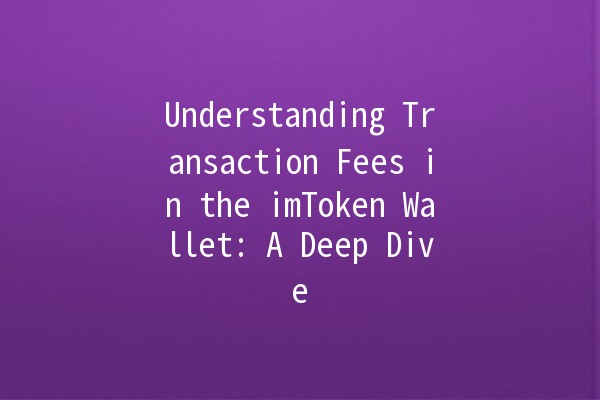As cryptocurrency continues to gain traction, managing digital assets effectively has become increasingly important. One of the vital aspects of using a cryptocurrency wallet like imToken is understanding transaction fees associated with each transfer. This article explores how to view and manage transaction fees in the imToken wallet, providing practical tips to enhance your productivity and optimize your wallet's performance.
Transaction fees are charges incurred when sending or receiving cryptocurrency. They incentivize miners or validators to process and confirm transactions on the blockchain. The fees fluctuate based on network demand and other factors, making it crucial for users to monitor them, especially during periods of high activity.

Before diving into how to manage and view fees, it's vital to understand the structure behind them. Different cryptocurrencies have various fee models. For example, Bitcoin's fees are often determined by the size of the transaction in bytes, while Ethereum's fees are based on the gas price and how complex the transaction is.
Practical Application: Familiarize yourself with the fee structures of the cryptocurrencies you hold in your imToken wallet. This understanding helps you predict potential costs before initiating a transaction, allowing better financial planning.
imToken provides users with live fee estimates based on current network conditions. Users can view estimated fees while preparing a transaction, ensuring they are aware of the costs involved before confirming.
Practical Application: Before confirming any transaction, always check the live fee estimates within your imToken wallet. This practice not only provides transparency but also allows you to select the optimal time for transactions when fees might be lower.
Cryptocurrency networks can experience congestion, resulting in higher fees during peak times. By monitoring network activity, you can choose to initiate transactions during offpeak hours to reduce costs.
Practical Application: Utilize tools and websites that track network congestion and fee trends. By monitoring this data, you can time your transactions to coincide with lower fees, maximizing your savings.
imToken allows users to set custom transaction fees within their wallets. While opting for lower fees may result in slower transaction processing times, it can save money in the long run.
Practical Application: If your transaction isn't timesensitive, consider adjusting the fee slider in imToken to a lower setting. This strategy can be especially beneficial after a significant purchase or in times of high activity.
Cryptocurrency wallets like imToken frequently update their features and user interfaces. Being aware of these changes is crucial for optimizing your transaction fee management.
Practical Application: Regularly check for updates in your imToken wallet. Often, new features or improvements can offer better insights into fees or additional options for customizing your transactions.
Open your imToken wallet application. Ensure that you are logged into the correct account containing the cryptocurrency you wish to transact.
Tap on the "Transfer" or "Send" button for the cryptocurrency you wish to use.
Enter the recipient's wallet address and the amount to be sent.
Once you've entered the transaction details, imToken will display the estimated transaction fee before you confirm the transaction.
The fees will be shown alongside the total amount being sent, allowing you to review your costs.
Optionally, you can adjust the fee settings here, to set a custom fee.
After reviewing the transaction details and fees, tap on the "Confirm" button to complete the process.
To keep track of past fees and transactions, navigate to the transaction history section. Here, you can view the details of each completed transaction, including the fees incurred.
Transaction fees are influenced by several factors, including network congestion, the complexity of the transaction, and the specific blockchain’s fee structure. During times of high demand, fees may rise significantly as users compete to have their transactions processed quickly.
Yes, imToken allows you to set a custom fee, even lower than the suggested amount. However, be aware that setting a lower fee may result in delayed processing times, especially during network congestion.
To view previous transaction fees, navigate to the transaction history section within the wallet. Each completed transaction will display the associated fees, enabling you to analyze your past expenses.
While fees are an inherent part of blockchain transactions, you can avoid high costs by timing your transactions during offpeak hours, utilizing custom fees, and selecting lower urgency settings for your transactions.
Fixed transaction fees remain constant regardless of network conditions. In contrast, variable fees fluctuate based on realtime network demand and congestion, often dynamically adjusting to ensure timely transaction processing.
Once a transaction has been confirmed on the blockchain, transaction fees cannot be reclaimed. Therefore, it is crucial to confirm all transaction details and fees before proceeding with a transfer.
Understanding transaction fees in the imToken wallet is essential for anyone looking to manage their cryptocurrencies effectively. By familiarizing yourself with fee structures, utilizing live fee estimates, optimizing transaction timing, and taking advantage of customizable fee settings, you can navigate the world of cryptocurrency transactions more efficiently.
Armed with these strategies, you are now better equipped to handle transaction fees in the imToken wallet, helping you to maximize your savings while ensuring prompt and secure transactions. As the cryptocurrency landscape continues to evolve, keeping informed about best practices and wallet features will serve you well in managing your digital assets effectively.